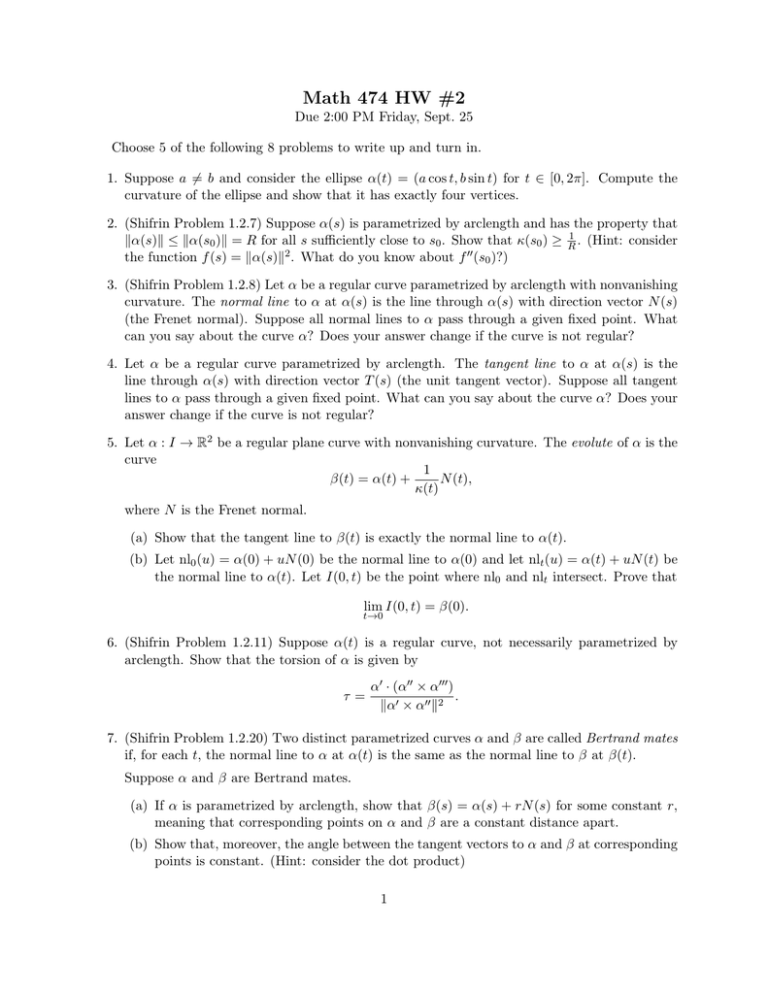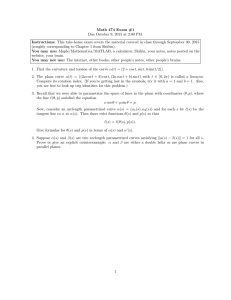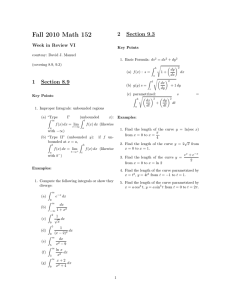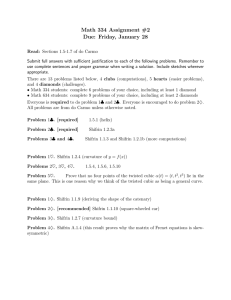Math 474 HW #2
advertisement

Math 474 HW #2 Due 2:00 PM Friday, Sept. 25 Choose 5 of the following 8 problems to write up and turn in. 1. Suppose a 6= b and consider the ellipse α(t) = (a cos t, b sin t) for t ∈ [0, 2π]. Compute the curvature of the ellipse and show that it has exactly four vertices. 2. (Shifrin Problem 1.2.7) Suppose α(s) is parametrized by arclength and has the property that kα(s)k ≤ kα(s0 )k = R for all s sufficiently close to s0 . Show that κ(s0 ) ≥ R1 . (Hint: consider the function f (s) = kα(s)k2 . What do you know about f 00 (s0 )?) 3. (Shifrin Problem 1.2.8) Let α be a regular curve parametrized by arclength with nonvanishing curvature. The normal line to α at α(s) is the line through α(s) with direction vector N (s) (the Frenet normal). Suppose all normal lines to α pass through a given fixed point. What can you say about the curve α? Does your answer change if the curve is not regular? 4. Let α be a regular curve parametrized by arclength. The tangent line to α at α(s) is the line through α(s) with direction vector T (s) (the unit tangent vector). Suppose all tangent lines to α pass through a given fixed point. What can you say about the curve α? Does your answer change if the curve is not regular? 5. Let α : I → R2 be a regular plane curve with nonvanishing curvature. The evolute of α is the curve 1 β(t) = α(t) + N (t), κ(t) where N is the Frenet normal. (a) Show that the tangent line to β(t) is exactly the normal line to α(t). (b) Let nl0 (u) = α(0) + uN (0) be the normal line to α(0) and let nlt (u) = α(t) + uN (t) be the normal line to α(t). Let I(0, t) be the point where nl0 and nlt intersect. Prove that lim I(0, t) = β(0). t→0 6. (Shifrin Problem 1.2.11) Suppose α(t) is a regular curve, not necessarily parametrized by arclength. Show that the torsion of α is given by τ= α0 · (α00 × α000 ) . kα0 × α00 k2 7. (Shifrin Problem 1.2.20) Two distinct parametrized curves α and β are called Bertrand mates if, for each t, the normal line to α at α(t) is the same as the normal line to β at β(t). Suppose α and β are Bertrand mates. (a) If α is parametrized by arclength, show that β(s) = α(s) + rN (s) for some constant r, meaning that corresponding points on α and β are a constant distance apart. (b) Show that, moreover, the angle between the tangent vectors to α and β at corresponding points is constant. (Hint: consider the dot product) 1 (c) Suppose α is parametrized by arclength and that both κ and τ are nonvanishing. Show that α has a Bertrand mate β if and only if there are constants r and c so that rκ+cτ = 1. (d) Show that a curve α that has more than one Bertrand mate must be a helix (and hence have infinitely many Bertrand mates). 8. Recall that the Bishop frame for a curve α(s) defines associated quantities k1 (s) and k2 (s). The parametrized plane curve (k1 (s), k2 (s)) is called the normal development of the curve α. Compute the Bishop frame and normal development of a helix. (Hint: One strategy is to use your answer to HW 1, Problem 2 to compute the Frenet frame of the helix, then write the first Bishop normal vector N1 as N1 (s) = cos(θ(s))N (s) + sin(θ(s))B(s), where θ(s) is unknown. Use the fact that N10 (s) is parallel to T (s) to find an equation for θ0 (s), integrate to find θ(s), and plug the result into the above equation.) 2







